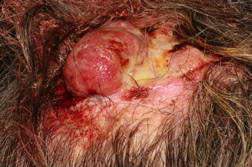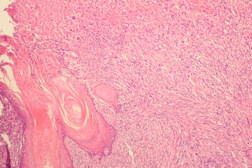Intracranial anaplastic meningioma presenting as a cutaneous lesion: A case report of a cutaneous meningioma
Published Web Location
https://doi.org/10.5070/D316v7q6s1Main Content
Intracranial anaplastic meningioma presenting as a cutaneous lesion: A case report of a cutaneous meningioma
Şule Güngör1, Gonca Gökdemir1, Nagehan Tarıkçı1, Tülay Sayılgan2, Şirzat Bek3
Dermatology Online Journal 18 (9): 6
1. Dermatology Department2. Pathology Department
3. Neurosurgery Department
Okmeydanı Training and Research Hospital, İstanbul, Turkey
Abstract
Meningiomas are tumors of the central nervous system that rarely present as extracranial soft tissue masses. Meningioma of the skin is referred to as cutaneous meningioma. Cutaneous meningioma of the scalp is extremely rare and may cause diagnostic challenges. A 70-year-old female patient presented with a painless mass on her scalp. A punch biopsy was performed; histological examination of the specimen revealed an infiltration of spindle-shaped and epithelioid atypical cells arranged in whorls. Immunohistochemistry was positive for vimentin and epithelial membrane antigen. On magnetic resonance imaging, a large intracranial mass eroding through the skull was observed. A diagnosis of intracranial anaplastic meningioma was established and excision was performed in the Department of Neurosurgery. It is important to consider intracranial tumors in the differential diagnosis of nodules on scalp.
Introduction
Meningiomas are tumors of the central nervous system (CNS) that rarely present as extracranial soft tissue masses [1]. Meningioma of the skin is referred to as cutaneous meningioma. Cutaneous meningioma of the scalp is extremely rare and may cause diagnostic challenges [2, 3]. As they may be associated with intracranial lesions, intracranial masses should also be investigated in patients presenting with cutaneous meningioma of the scalp.
In the current case report, we present a patient with intracranial anaplastic meningioma that presented as a mass on the scalp.
Case presentation
 |
| Figure 3 |
|---|
| Figure 3. Focal EMA positivity throughout the tumor supporting the meningial origin, A: Punch biopsy material; B: Excision material (EMA x200). |
A 70-year-old female patient presented with a painless mass on her scalp existing for 10 months. Her clinical examination revealed a single, rubbery, non-tender, ulcerated mass with a size of 4 x 6 cm on the left posterior parietal region (Figure 1). A punch biopsy was performed with a suspicion of malignant proliferating trichilemmal tumor, squamous cell carcinoma, or cutaneous metastasis of an internal tumor. Histological examination of the specimen revealed an infiltration of spindle-shaped and epithelioid atypical cells arranged in whorls, which raised the suspicion of an anaplastic meningioma or a soft tissue sarcoma (Figure 2). The nuclei of the cells were prominent, highly pleomorphic, and hyperchromatic; numerous mitotic figures were observed. Immunohistochemistry was positive for vimentin and epithelial membrane antigen (EMA). However, it was negative for cytokeratin, synaptophysin, chromogranin, thyroid transcription factor-1 (TTF-1), CD34, S-100, CD99, CD68, smooth muscle actin, desmin, HMB-45, and Melan-A (Figure 3). EMA staining was not diffuse, but supported the diagnosis of an anaplastic meningioma based on the characteristic morphology. On magnetic resonance imaging (MRI), a large intracranial mass eroding through the skull was observed. A diagnosis of intracranial anaplastic meningioma was established and excision was performed in the Department of Neurosurgery. The diagnosis was also confirmed by the histological examination of the postoperative specimen. The patient has been receiving radiation therapy and is being followed in the Department of Oncology since the operation.
Discussion
Cutaneous meningiomas are classified into three groups, including type I, type II, and Type III meningiomas. Type III cutaneous meningiomas are CNS meningiomas extending into the skin and infiltrating across bone or a bone defect, particularly at places of decreased resistance such as sutures or foramina [3].
Based on the clinical and pathological findings, our case represented the type III variant of cutaneous meningioma. The primary tumor was a CNS tumor and the visible mass on the scalp led the patient to seek health care. The patient was unaware of her disease until the appearance of the nodule on her scalp. She did not have neurological symptoms.
In the literature, it has been emphasized that cutaneous meningioma should be considered if nodules are located on the midline [2, 3, 4]. However, the tumor can extend into the skin by infiltrating the skull and can be located far from the midline, as was in our case. Because of the aggressive behavior of anaplastic meningioma, we suggest the mass may have extended into the skin by infiltrating across bone instead of herniating through sutures in our case.
Lesions of the scalp may be associated with a wide range of diseases; numerous cutaneous or extracutaneous diseases should be considered in the differential diagnosis. Particularly, lipoma, trichilemmal cyst, or tumor, squamous cell carcinoma, basal cell carcinoma, Merkel cell carcinoma, and cutaneous metastasis of carcinomas may present as a mass on the scalp [2, 3, 5]. To distinguish these tumors, histological examination should be performed.
In the present case, cutaneous metastases, in addition to cutaneous tumors, were considered in the clinical differential diagnosis. The whorl structures observed in the histological examination caused the pathologist to consider a diagnosis of meningioma and cranial MRI revealed an intracranial mass.
In conclusion, not only cutaneous tumors but also metastases or extensions of internal tumors, particularly cranial tumors, should be considered in scalp lesions.
References
1. Fung MA, Grekin RC, Odom RB. Intracranial malignant meningioma mimicking frontalis- associated lipoma of the forehead. J Am Acad Dermatol. 1996; 34: 306-7. [PubMed]2. Fenandez A, Mateos D, Fraga GJ, Garcia-Diez A. Cutaneous meningioma: extracranial extension from an intracranial tumour. Clin Exp Dermatol. 2009; 34: e1001-3. [PubMed]
3. Lopez DA, Silvers DN, Helwing EB. Cutaneous meningiomas: a clinicopathologic study. Cancer. 1974; 34: 728-44. [PubMed]
4. Zaaroor M, Borovich B, Bassan L, Doron Y, Gruszkiewicz J. Primary cutaneous extravertebral meningioma. J Neurosurg. 1984; 60: 1097-8. [PubMed]
5. Richmond HM, Duvic M, MacFarlane DF. Primary and metastatic malignant tumors of the scalp. Am J Clin Dermatol. 2010; 11: 233-46. [PubMed]
© 2012 Dermatology Online Journal



